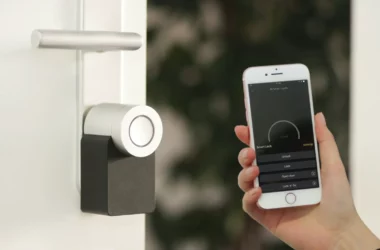Introduction
Good posture isn’t just about looking confident; it’s a cornerstone of long-term health that can significantly impact your well-being. While many of us acknowledge the importance of maintaining a straight spine and even shoulders, the realities of modern life—such as long hours spent in front of a computer—often make it challenging. Enter the innovative world of wearable tech for posture correction, a burgeoning field that combines smart technology with biomechanics to help you achieve and maintain a healthier stance.
In this ultimate guide, we’ll dive deep into the smart posture devices that are designed to make posture correction seamless and effective. Whether you’re someone who struggles with slouching at your desk job or someone keen on improving spinal health, wearable tech offers a promising solution. So, let’s get started on understanding how these digital marvels can help you stand a little taller and live a lot healthier.
Stay tuned as we explore everything from the mechanics of posture-correcting wearables to tips on choosing the right device for you.
The Problem with Poor Posture
We often hear that poor posture is bad for us, but do we truly understand the extent of its impact? The consequences of poor posture go beyond merely looking slumped or lacking confidence; it can have severe repercussions for your overall health, particularly your spinal health and muscle structure.
Health Consequences
Spinal Health
A poor posture can lead to a range of spinal health issues. It places excess pressure on your spine, leading to misalignment and, in extreme cases, spinal deformities. This can result in chronic back pain, reduced flexibility, and even complications like herniated discs. The importance of spinal health can’t be overstated, especially as it plays a critical role in your overall well-being.
Muscle Tension
Incorrect posture often leads to muscle tension and tightness, especially in the neck, shoulders, and lower back. This tension can result in frequent headaches, muscle strains, and fatigue, limiting your physical capabilities and overall quality of life.
Psychological Effects
It may surprise you to know that poor posture also has psychological effects. Studies have shown that slouching can lead to reduced self-esteem, increased levels of stress, and even depressive symptoms. Your body language speaks not just to others but also to yourself, and a slumped posture sends a signal to your brain that you are less energetic and less capable.
By understanding the biomechanics behind posture and the emerging field of health tech for posture, you can equip yourself with the knowledge and tools to combat these negative outcomes effectively. Future sections will delve into the innovative solutions that wearable technology offers for posture correction, aiming to tackle the issues discussed above.
What is Wearable Tech for Posture Correction?
As the adverse effects of poor posture become more recognized, the demand for effective solutions is on the rise. One revolutionary approach lies in the use of posture-correcting wearables, a subset of smart devices designed to monitor and improve your stance. But what exactly is wearable tech for posture correction, and how does it work? In this section, we’ll demystify these high-tech helpers and explain their mechanics.
Definition and Types of Posture-Correcting Wearables
Wearable tech for posture correction consists of smart devices that you can attach to your body or clothing. These devices come in various forms, such as:
- Smart Brace: Similar to a traditional back brace but enhanced with sensors to monitor spinal alignment.
- Posture Tracker: Often a smaller device that clips onto your clothing and vibrates when you slouch.
- Smart Shirt: A piece of clothing with integrated sensors that monitor your posture throughout the day.
- Fitness Band with Posture Monitoring: These bands offer multiple functionalities, including tracking your steps, heart rate, and, notably, your posture.
How They Work
So, how do these digital posture monitoring devices function? Most use a combination of accelerometers, gyroscopes, and sometimes even machine learning algorithms to understand your body’s position. Here’s a general workflow:
- Sensing: The device’s sensors collect data about the angle of your spine, the tilt of your shoulders, and other biomechanical markers.
- Analysis: This data is then analyzed in real-time to determine whether you are maintaining a healthy posture.
- Feedback: If poor posture is detected, the device will alert you—often via vibration, sound, or a notification on your smartphone—to correct your stance.
- Tracking & Reporting: Many devices come with accompanying apps that track your progress over time, offering insights and analytics that can help you make sustained improvements.
These devices thus offer a comprehensive approach to posture correcting wearables, combining instant feedback with long-term tracking to ensure that you’re continuously moving toward a healthier posture.
Benefits of Smart Posture Correctors
Having discussed the complexities of poor posture and the mechanics of wearable technology aimed at correcting it, let’s delve into the real-world advantages. Why should you consider investing in these devices? What are the tangible benefits of smart posture correctors that make them worth your attention? In this section, we’ll discuss their effectiveness, convenience, and the invaluable feature of real-time feedback.
Effectiveness
One of the most compelling reasons to consider a smart posture corrector is its effectiveness. Unlike traditional posture braces that offer a one-size-fits-all approach, smart posture correctors are often customizable. They can be adjusted to fit your specific needs, providing targeted support where you need it most. This allows for more effective posture correction over the long term, and many users report noticeable improvements within just a few weeks of regular use.
Convenience
Another major benefit is the convenience factor. Most smart posture correctors are designed to be discreet and comfortable, enabling you to wear them throughout the day without drawing attention. Whether you’re sitting at your desk, going for a jog, or even attending a social event, these devices integrate seamlessly into various aspects of daily life. With simple charging solutions and easy-to-use interfaces, the convenience is hard to beat.
Real-Time Feedback
Perhaps the most revolutionary aspect is the real-time feedback these devices provide. Gone are the days when you had to constantly remind yourself to sit up straight or rely on periodic check-ups at the chiropractor. Smart posture correctors alert you the moment you deviate from a healthy posture, allowing for immediate correction. This instant feedback loop is instrumental in helping you internalize good posture habits, making the process much more manageable and less time-consuming.
How to Choose the Right Wearable for Posture Correction
By now, you’re probably convinced of the merits of wearable tech for posture correction. But with various options flooding the market, how do you select the one that best suits your needs? The right choice isn’t one-size-fits-all and involves considering several key factors like budget, types of wearables, and device reliability. In this section, we’ll guide you through how to choose the right wearable for posture correction, so you can make an informed decision.
Budget Considerations
First and foremost, consider your budget. The cost of posture-correcting wearables can range from as low as $20 for basic models to upwards of $200 for more advanced options with multiple functionalities. While it might be tempting to go for the cheapest option, remember that you often get what you pay for. Evaluate the features offered against your budget constraints to find a device that offers good value for the price.
Types of Wearables
As discussed earlier, there are several types of posture-correcting wearables, each with its unique set of features:
- Smart Brace: Ideal for those looking for comprehensive support and monitoring, though usually on the higher end price-wise.
- Posture Tracker: A less intrusive but effective solution, often mid-range in price.
- Smart Shirt: Suitable for those who want a more integrated experience, but could be on the pricier side.
- Fitness Band with Posture Monitoring: A multipurpose option that also tracks other health metrics, offering good value for the price.
Understanding the pros and cons of each type will help you decide which device best suits your specific needs.
Reliability and Battery Life
Last but not least, consider the reliability and battery life of the device. Read customer reviews, research the brand’s reputation, and look for any certifications that can vouch for the device’s quality. Battery life is another critical factor, especially if you plan to wear the device throughout the day. Check how often the device needs to be charged and whether it offers fast charging options.
Top Wearable Devices for Correcting Posture: Reviews
The market is saturated with a variety of wearable options that promise to correct your posture. But which ones truly deliver on that promise? To guide you through the maze of choices, we’ve compiled a list of top wearable devices for correcting posture, based on extensive research, features, and customer feedback. In this section, we’ll review 3-5 top devices, focusing on their pros and cons.
Upright GO 2
- Pros:
- Highly Effective: Numerous customers attest to significant posture improvement within weeks.
- Real-time Feedback: Instant vibration alerts for immediate posture correction.
- Compact and Discreet: Small enough to be unnoticeable under clothing.
- Cons:
- Battery Life: Needs daily charging, which can be inconvenient for some users.
- Price: On the higher end, retailing around $100.
- Customer Feedback
- Most reviews are overwhelmingly positive, praising its effectiveness and easy-to-use app interface.
Lumo Lift
- Pros:
- Dual Functionality: Acts as a posture corrector and an activity tracker.
- Long Battery Life: Lasts up to five days on a single charge.
- Magnetic Clip: Easily attaches to any piece of clothing.
- Cons:
- Learning Curve: Takes time to get accustomed to the alerts and settings.
- Limited App Compatibility: Not compatible with all smartphones.
- Customer Feedback:
- The device has received generally favorable reviews, especially applauding its battery life and dual functionality.
Alex Posture Tracker
- Pros:
- Head Position Monitoring: Unique in its focus on correcting forward head posture.
- Customizable Alerts: Allows you to set the frequency and type of alerts.
- Affordable: Priced under $50, making it accessible for most budgets.
- Cons:
- Limited to Neck Posture: Does not provide comprehensive spinal posture analysis.
- Requires Smartphone: Must be paired with a smartphone for functionality.
- Customer Feedback
- Users appreciate the focus on neck posture but wish for a more comprehensive solution.
Wearable Tech vs Traditional Braces for Posture
The market for posture-correcting solutions is as diverse as the problems they aim to solve. One question that often arises is how modern wearable tech stacks up against traditional braces for posture correction. In this section, we’ll dive into the key aspects where these two diverge, focusing on their effectiveness, comfort and convenience, and cost-effectiveness. This comparison should help you decide which approach suits you best when it comes to improving your posture.
Comparison of Effectiveness
Wearable Tech
Modern posture-correcting wearables offer real-time feedback and often use advanced algorithms to provide a more nuanced understanding of your posture. This results in targeted and effective posture correction, with many users reporting improvements within weeks.
Traditional Braces
While traditional braces do provide support, they don’t offer real-time feedback or advanced analytics. They generally work by physically holding your body in a specific position, which may or may not be optimal for long-term posture improvement.
Comfort and Convenience
Wearable Tech
These devices are designed to be discreet and comfortable, fitting seamlessly into your daily routine. You can wear them under clothes, and they often come with user-friendly apps to track your progress.
Traditional Braces
In contrast, traditional braces are often bulkier and may require additional adjustments throughout the day. They can also be visible under clothing, making them less convenient for all-day wear.
Cost-Effectiveness
Wearable Tech
Although many posture-correcting wearables are on the pricier side, ranging from $50 to $200, they offer multifaceted functionality. The ongoing tracking and real-time feedback often justify the higher initial investment.
Traditional Braces
Traditional braces are generally cheaper, with prices ranging from $20 to $50. However, they offer a one-size-fits-all approach with limited features, making them less cost-effective in the long run for those serious about improving their posture.
How to Maximize the Benefits
So you’ve decided to invest in a posture-correcting wearable, but how can you make the most out of this investment? There’s more to correcting your posture than simply strapping on a device. In this section, we’ll explore how to maximize the benefits of your posture-correcting wearable, providing tips on proper usage and how you can combine wearables with exercises for optimal results.
Proper Usage Tips
Positioning
Ensure that the device is correctly positioned, whether it’s clipped to your shirt or strapped around your waist. Follow the manufacturer’s guidelines for optimal performance.
Consistency is Key
Wearing your device sporadically won’t provide the results you’re looking for. Make it a part of your daily routine to benefit from continuous monitoring and feedback.
Update Settings
Take advantage of the app settings to customize the experience. Whether you need gentle reminders or more persistent nudges, most ergonomic wearables allow for customization.
Combining Wearables with Exercises
Posture-Specific Workouts
While wearables are fantastic tools for real-time monitoring, they’re most effective when combined with targeted exercises to strengthen your back and core muscles.
Yoga and Pilates
These disciplines focus heavily on alignment and are excellent complements to fitness wearables for posture. Consider incorporating a weekly class into your routine.
Consult Professionals
If you’re dealing with more severe posture issues, consider consulting a physiotherapist who can recommend specific exercises to perform alongside using your wearable.
Conclusion
Choosing the right wearable tech for posture correction is more than just a matter of convenience—it’s an investment in your long-term health and well-being. Throughout this comprehensive guide, we’ve explored various aspects to consider when making your choice, including the effectiveness, types, and cost considerations associated with different smart posture devices on the market. Additionally, we’ve highlighted how to maximize the benefits of these devices through proper usage and combining them with targeted exercises.
Correcting your posture is not a one-off endeavor but a continuous journey. Fortunately, modern wearable tech offers real-time feedback, analytics, and other advanced features that traditional methods simply can’t match. With the right device and a committed approach, improving your posture is more attainable than ever.
So what are you waiting for? Take the first step towards a healthier, more confident you. Invest in wearable tech for posture correction, and don’t forget to supplement this technology with exercises and proper lifestyle changes. Your future self will thank you.
Thank you for taking the time to read this guide. If you’ve found it valuable, please consider sharing it with others who might benefit. Here’s to a future of better posture and improved well-being!
By focusing on the primary keywords “smart posture devices” and “wearable tech for posture correction,” this conclusion serves as a summary and final encouragement for readers, while also helping to improve the blog’s SEO ranking.
FAQ (Frequently Asked Questions)
What is wearable tech for posture correction?
Wearable tech for posture correction refers to smart devices designed to monitor, track, and improve your posture. These can range from smart braces to posture trackers and even integrated smart clothing.
How effective are smart posture devices compared to traditional braces?
Smart posture devices often offer real-time feedback and analytics, making them generally more effective for long-term posture improvement compared to traditional braces, which only provide physical support.
How do I choose the right wearable for my needs?
Consider factors like your budget, the type of wearable (smart brace, posture tracker, etc.), and the device’s reliability and battery life. Our section on “How to Choose the Right Wearable for Posture Correction” provides an in-depth guide.
Can I combine wearables with other forms of exercise?
Absolutely, in fact, it’s encouraged! Wearables are most effective when combined with targeted exercises to strengthen your back and core muscles. Yoga and Pilates are also excellent complements.
Are posture-correcting wearables comfortable for all-day use?
Comfort varies from device to device and person to person. However, many modern wearables are designed to be discreet and comfortable for extended wear. Reading customer reviews can provide more insights into the comfort level of a specific device.
How often should I wear my posture-correcting wearable?
Consistency is key. Making it a part of your daily routine will yield the best results. However, each device comes with its own set of guidelines, so consult the manufacturer’s instructions for optimal usage.
What is the typical price range for posture-correcting wearables?
Prices can range from as low as $20 for basic models to upwards of $200 for advanced devices with multiple functionalities.
This FAQ section should serve as a quick reference guide for readers, offering immediate answers to common questions while also enhancing the article’s SEO value.









